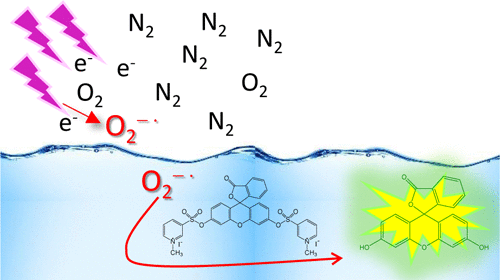Our official English website, www.x-mol.net, welcomes your feedback! (Note: you will need to create a separate account there.)
Application of Fluorescence-Based Probes for the Determination of Superoxide in Water Treated with Air Non-thermal Plasma.
ACS Sensors ( IF 8.9 ) Pub Date : 2020-08-17 , DOI: 10.1021/acssensors.0c01042 Gabriele Cabrellon 1 , Francesco Tampieri 1 , Andrea Rossa 1 , Antonio Barbon 1 , Ester Marotta 1 , Cristina Paradisi 1
ACS Sensors ( IF 8.9 ) Pub Date : 2020-08-17 , DOI: 10.1021/acssensors.0c01042 Gabriele Cabrellon 1 , Francesco Tampieri 1 , Andrea Rossa 1 , Antonio Barbon 1 , Ester Marotta 1 , Cristina Paradisi 1
Affiliation

|
Superoxide is one of the reactive oxygen species (ROS) in non-thermal plasmas generated by electrical discharges in air at room temperature and atmospheric pressure. One important application of such plasmas is the activation of advanced oxidation processes for air and water decontaminating treatments. When in contact with aqueous media, ROS and notably superoxide can react at the plasma/liquid interface or transfer and react into the liquid. While the detection of superoxide in plasma-treated water has been reported in the literature, to the best of our knowledge, quantitative determinations are lacking. We report here the determination of superoxide rate of formation and steady-state concentration in water subjected to air non-thermal plasma in a streamer discharge reactor used previously to treat various organic contaminants. After detecting the presence of superoxide by spin-trapping and electron paramagnetic resonance analyses, we applied superoxide-selective fluorescent probes to carry out quantitative determinations. The first probe tested, 3′,6′-bis(diphenylphosphinyl) fluorescein (PF-1), was not sufficiently soluble, but the second one, fluorescein-bis-[(N-methylpyridinium-3-yl)sulfonate iodide] (FMSI), was applied successfully. Under typical plasma operating conditions, the rate of superoxide formation and its steady-state concentration were (0.27 ± 0.15) μM s–1 and (0.007 ± 0.004) nM, respectively. The procedure outlined here can be usefully applied to detect and quantify superoxide in water treated by different plasma sources in various types of plasma reactors.
中文翻译:

荧光探针在空气非热等离子体处理水中测定超氧化物的应用。
超氧化物是在室温和大气压下空气中放电产生的非热等离子体中的活性氧(ROS)之一。这种等离子体的一个重要应用是激活高级氧化工艺,以进行空气和水净化处理。当与水性介质接触时,ROS(尤其是超氧化物)会在血浆/液体界面发生反应或转移并进入液体。尽管在文献中已经报道了对血浆处理水中超氧化物的检测,但据我们所知,尚缺乏定量测定方法。我们在这里报告了以前用于处理各种有机污染物的流光放电反应器中经受空气非热等离子体的水中超氧化物形成速率和稳态浓度的测定。通过自旋阱和电子顺磁共振分析检测到超氧化物的存在后,我们应用了超氧化物选择性荧光探针进行定量测定。测试的第一个探针3',6'-双(二苯基膦基)荧光素(PF-1)不能充分溶解,但是第二个探针是荧光素-双-[(N-甲基吡啶-3-基)磺酸碘化物(FMSI)已成功应用。在典型的等离子体操作条件下,超氧化物的形成速率及其稳态浓度分别为(0.27±0.15)μMs –1和(0.007±0.004)nM。此处概述的过程可用于检测和定量各种类型的等离子体反应器中由不同等离子体源处理过的水中的超氧化物。
更新日期:2020-09-25
中文翻译:

荧光探针在空气非热等离子体处理水中测定超氧化物的应用。
超氧化物是在室温和大气压下空气中放电产生的非热等离子体中的活性氧(ROS)之一。这种等离子体的一个重要应用是激活高级氧化工艺,以进行空气和水净化处理。当与水性介质接触时,ROS(尤其是超氧化物)会在血浆/液体界面发生反应或转移并进入液体。尽管在文献中已经报道了对血浆处理水中超氧化物的检测,但据我们所知,尚缺乏定量测定方法。我们在这里报告了以前用于处理各种有机污染物的流光放电反应器中经受空气非热等离子体的水中超氧化物形成速率和稳态浓度的测定。通过自旋阱和电子顺磁共振分析检测到超氧化物的存在后,我们应用了超氧化物选择性荧光探针进行定量测定。测试的第一个探针3',6'-双(二苯基膦基)荧光素(PF-1)不能充分溶解,但是第二个探针是荧光素-双-[(N-甲基吡啶-3-基)磺酸碘化物(FMSI)已成功应用。在典型的等离子体操作条件下,超氧化物的形成速率及其稳态浓度分别为(0.27±0.15)μMs –1和(0.007±0.004)nM。此处概述的过程可用于检测和定量各种类型的等离子体反应器中由不同等离子体源处理过的水中的超氧化物。



























 京公网安备 11010802027423号
京公网安备 11010802027423号